←Return to Chapter 2: My Writing Journal Begins
(A reminder that I’ve included links throughout the text for more information on people, places, and things mentioned in case something piques your interest.)
Oof. It was summer of 1995, I was living in the suburbs of Atlanta, Georgia, still working full-time as a systems engineer and writing romantic fiction in my spare time. And not only had I just promised Harlequin editor Brenda Chin I would send three chapters and a synopsis for a book I hadn’t even started, but I’d promised her it would be funny!
In the future I would come to realize I produce my best work under pressure, but at that moment, I had no confidence or proof that I could do anything of the sort. In hindsight, though, I did have a few things going for me.
I’d been reading romance novels for years and unwittingly soaking up the rhythm of storytelling and the “tropes” of the genre. A trope is an element that defines a certain type of story. For example, one romance trope is a happy ending, which is generally considered a requirement. Other popular tropes are love triangle, forced proximity, enemies to lovers, friends to lovers, reunion stories, opposites attract, etc. I inherently knew the tropes even though I hadn’t yet experimented with writing all of them, which is why I was able to pitch a humorous premise on the spot of a woman who enrolls in a clinical study on pheromones and suddenly becomes irresistible to every man she meets.
Also, I was a huge fan of romantic comedy movies of the time like When Harry Met Sally, Doc Hollywood, Pretty Woman, Sleepless in Seattle, and The Bodyguard, so I had a sense for what I liked about them. (People sometimes ask me if I patterned my first book after the rom com Love Potion No. 9, but as of this writing, strangely enough, I’ve never seen that movie, although I just added it to my watch list because I think I probably should see it.)
Also, since the romantic comedy line the editor was acquiring for hadn’t yet been launched, there were no guidelines except for wordcount, which was approximately 60,000 words. (As a reference, that’s about 250 double-spaced manuscript pages.) The fact that I didn’t have a lot of constraints and no books to read and learn from meant the possibilities were wide open.
And the final ace up my sleeve was my critique group. While Rita Herron has been my mainstay critique partner over the years, other members (Mary, Hilary, Pam, Carmen) came and went from our group that met weekly and all were very helpful in reading my pages and offering up feedback.
With those advantages and a cheering section, I set to work outlining a book with the premise I’d tossed out so casually.
Here is where I should back up a little and address comments I received at the time and still hear when people learn my first career was computer programming (now referred to using the much cooler phrase “coding”). The common observation is that writing fiction seems to be at the opposite end of the spectrum from programming computers—one seems wildly creative, and the other, notsomuch. But in truth, there’s a lot of creativity in coding because the goal is to write a program to solve a problem, and every programmer will do it differently. Also, coders are excellent typists! (Okay, keyboarders.) I’d be remiss if I didn’t acknowledge the fact that learning to touch-type in high school on an IBM Selectric Typewriter and keyboarding daily in college and in my job was a huge boon when it came to writing fiction in terms of sheer speed and accuracy.
Another skill I acquired in programming was outlining. When I first learned to program, processing speed was slow and storage space was limited, so it was critical to write an efficient program that was successful on the first or second pass. To that end, I learned to “flowchart” my programs—mapping out the process using certain shapes for certain functions. For example, a diamond shaped box indicated a decision that had to be made, with arrows pointing in different directions depending on results of the decision. I literally used a plastic template guide to draw the steps of my process and in many cases, the flowchart had to be attached to the actual program that was printed on green and white continuous paper as proof of working through a problem before attempting to write the program.
So when compared side by side, writing a computer program and writing a book aren’t so different in terms of process, and there are lots of transferrable skills.
When I sat down to think about the story I had to write, I started by figuring out what trope would work best with the logline I’d pitched. If my heroine would become irresistible to every man she met, the most humorous setup would be for the hero to be the kind of man who wouldn’t normally be attracted to her—namely, someone opposite. So my trope would be “opposites attract.”
Further, I reasoned if the heroine was the type of person who would sign up for a clinical study, she would be impulsive and adventurous, and since the primary reason to sign up to be a lab rat is compensation, she would have an unpredictable vocation. I dabbled in art most of my life as a hobby and enjoyed doing figure drawing. So to fall back on something I had some insight into, I made the heroine an artist struggling to make a name for herself. I gave her the "soft" name of Ellie (begins and ends with a vowel). For the hero to be opposite, I made him a corporate lawyer with the “hard” name of Mark (begins and ends with a consonant). Then I devised a way for them to have to work together (forced proximity): she would be commissioned to paint his corporate portrait since he’d just been named partner in his firm. That felt like a good setup because the hero would be at an inflection point in his career and life.
Okay, I had the plot of my story, but I still needed the setup and the “meet cute.” For the heroine to be forced to sign up for a study on pheromones, I opened with her being let go from her “day” job of working for a city art council. BUT for the “promise of the premise” to work (i.e., the heroine becomes irresistible), I also needed for her and the hero to meet before she enrolled in the study so we could see that he’s not bowled over by her (nor she by him) when they first cross paths. To show that, I decided to let her be sitting in a café going over job listings, and the distracted workaholic hero accidentally spills something on her while he’s on his phone. As strangers, they clash. Then the heroine signs up for the pheromone study and begins to take the pills. Then the heroine’s former boss, who feels terrible about having to let her go, passes her a commission from a local law firm to paint a corporate portrait. When the heroine shows up at the law firm, the hero and heroine realize they have to work together… and are attracted to each other. But is the hero interested only because of the pheromones? All of these elements I “flowcharted” in a word processing document and moved things around until the sequence made sense.
Sidebar: Can you see the black moment looming out there? She falls in love with him, but what happens when the clinical study is over and the pheromones vanish? For those of you interested in writing, it’s helpful if when you pitch the logline for your story, the black moment is obvious.
Okay, so I had my basic plot and my setup… now I just needed to write it! Easier said than done. Remember, I’d never written anything funny and didn’t know if I could. So I decided to borrow elements from those romantic comedy movies I loved. One of the tropes of rom coms of that era and a source of much of the humor was the gay best friend. I brought that trope into my story with the introduction of a character named Manny who would be my heroine’s roommate and confidante. Then I added more characters who would highlight the fact that the hero and heroine were opposites: the hero’s mother and family who have a certain type of woman in mind for the hero. I also gave the heroine a cat that the hero, who isn’t a pet person, would have to deal with.
And I layered in other details to prop up the general plotline in terms of scents and pheromones—I gave the heroine an interest in making her own perfume (which is why she’s attracted to the study in the first place). Gender mix-ups were all the rage in TV and movies at the time, so it gave me the idea to include a mix up regarding Ellie’s gay roommate. And lots of innuendo and double entendres.
I admit it—I put in everything I could think of that would make the story over the top because I was terrified the story wouldn’t be funny and I’d blow my chance to sell a book to the editor.
But I was also coming around to the idea that I enjoyed writing romantic comedy. I suppose what I didn't project in real life was something that came out naturally when I wrote, which is what the editor had recognized when she read my query letter in the workshop.
Writing every spare minute between my full-time job, I banged out a proposal (three chapters and a synopsis) in record time. I’d titled my story Irresistible, which seemed appropriate. My critique partners were kind enough to read my pages quickly and turn them around with comments. I printed the proposal and sent it off to editor Brenda Chin with a cover letter reminding her where we’d met and here’s the story she said she was interested in reading. And I waited to hear back.
And waited.
And waited.
Editors receive dozens of both requested and unsolicited manuscripts every day, which they have to read in addition to manuscripts they’ve already bought and are in different stages of the publishing process. So it’s not as if Brenda was sitting in her office waiting for my submission to arrive. I assumed she’d attended other writing events and had requested many manuscripts in the hopes some of them would fit the comedy line that was still being defined but now (I’d learned through a Romance Writers of America market update bulletin) was called Love & Laughter.
Meanwhile, since I had momentum, I decided to go ahead and finish writing the first draft of Irresistible, which I did over several weeks, workshopping it in my weekly critique group meetings.
A few months later, I attended the Moonlight & Magnolias writing conference in Atlanta sponsored by the Georgia Romance Writers. I hadn’t yet heard back from my submission, but I was still hopeful. At the conference I showed up for a workshop early and another woman was also early. We chatted and she introduced herself as an agent whose name I recognized. She asked what I wrote and I told her romantic comedy, as if I’d been doing it for years. She invited me to submit something to her and gave me her card. I was excited, but I managed to keep my cool (I think).
After the conference I submitted to her the finished manuscript of Irresistible and explained the proposal was with Brenda Chin who had requested it. At this point I was calling my home landline phone message machine to check for messages a couple of times a day, hoping for “good” news, and opening the mailbox when I got home, hoping not to see a returned envelope with “bad” news. One day I had a voice message from a woman with a British accent who introduced herself as Ruth Kagle, a colleague of the agent I’d spoken with at the conference. She said the original agent had decided my manuscript wasn’t for her but had passed it to Ruth who “quite liked it” and wanted to talk to me about representation. I was ecstatic! I returned Ruth’s call the following day and explained I hadn’t heard back from Brenda Chin as to whether she liked the proposal. Ruth said she’d call Brenda and let her know the manuscript was finished and if she wanted to read it, Ruth would send it to her before submitting it to other publishers.
Brenda did want to read the full manuscript, and meanwhile, I signed a representation agreement with Ruth’s agency. I was walking on air—a sale seemed to be within reach!
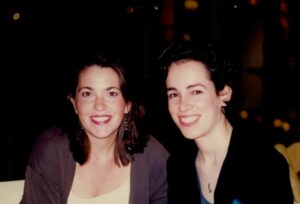
Me and my first literary agent Ruth Kagle.
Sidebar: A literary agent earns a percentage of all proceeds of their clients. No sale, no commission. But the general idea is an agent is worth more than their commission in terms of having direct access to editors to get projects read more quickly, and to negotiate higher advances than an author might be able to negotiate on their own. Material submitted through an agent is considered by editors to be “vetted” and typically—although not always—is considered a higher quality submission. Also, if an author has an agent, the editor has extra assurance that someone else will ensure the author delivers a manuscript on time. And some editors prefer to deal with agents when it comes to negotiating terms of a contract versus dealing with an unrepresented author who likely has to be schooled in what terms and clauses mean.
By this time it’s November of 1995. My day job was keeping me too busy to dwell too much on what was happening with my manuscript. I traveled alone to Sarasota, Florida to visit the headquarters of a small business my company was acquiring to get a handle on integrating their paperwork and systems into ours. The people at the office were rightfully worried about their jobs, so it wasn’t a welcoming atmosphere, combined with the fact that the hotel accommodations left a lot to be desired. Picture a musty room in an old strip motel with mismatched fake wood furniture and a wild flowered bedspread that hid unknown stains. The days were long and stressful—I stayed after hours to work alone. One night I dragged myself back to the motel late at night, then remembered to call my home phone messages to see if there was any news from my agent. To my surprise, she’d left a message to let me know that Brenda had called to make an offer on Irresistible! I was overjoyed! But it was too late to call my critique partners or family members to share my good news. Of course I was wide awake and wanting to celebrate!
So I left my room and walked to the outdoor vending machine in front of the motel and bought a can of ginger ale. I cracked it open and had a private little toast to my first sale. I know it sounds pitiful, but I still remember that sweet, sweet moment!
The next few weeks were like a bootcamp introduction to the world of publishing. My new editor Brenda called me to discuss revisions to the manuscript to get it into the best possible shape. One of the issues she brought up surprised me—at that time Harlequin had never featured an outted gay character in one of their books. So to be able to include Manny as-is, the decision had to make its way up to the top of the editorial ranks. Let me be clear that the hesitation was in no way reflective of how my editor or any individual at Harlequin felt about it—the top editorial execs had to decide how the inclusion would be received by readers at that time. Remember that many readers subscribed to Harlequin books and received every book in a particular line every month—they couldn’t pick and choose titles ahead of time. So including a gay character in a book that could be sent to readers who might not want to read about a gay character had to be weighed as a business decision.
While this was going on, I tackled other revisions to shape up the story, shore up characterization and improve the pacing. Brenda liked my title of Irresistible, but suggested we add a question mark to the end to make it more quirky and interesting. And I received my first publishing contract!
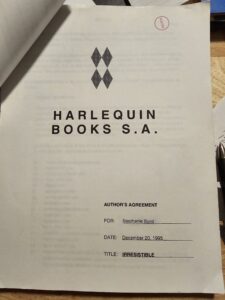
The title page of my first book contract.
Sidebar: It’s commonly believed that when an author signs a contract, they sell their copyright to the publisher, but that’s not the case unless the deal is specifically for and designated a “copyright buyout.” Generally, the author maintains ownership of their copyright and is simply licensing the use of the copyright to a publisher under terms spelled out in the contract in return for payment.
A book contract is a somewhat intimidating document about a half-inch thick that explains in detail what rights the publisher is licensing, and what rights are excluded and the author retains. For example, a publisher might purchase foreign language rights but exclude audiobook rights. The rights sold and retained are negotiated between the publisher and the author/the author’s agent. The contract also spells out payments to be made and at what times, royalty rates, sales bonuses, etc., plus the delivery date(s) and other actions the author agrees to, such as agreeing to promote a title when it’s released if the publisher sets up interviews, booksignings, etc. The contract also spells out the terms for which the licensing agreement can/will end and the rights will revert back to the author.
I went over the contract clause by clause with my agent until I understood what I was signing, then returned the contract. By the way, my first contract was for one book—that’s typical because it’s best for the publisher and the author to see if this arrangement is going to work out before committing to more than one project. But there’s usually a provision in the contract that the publisher gets first right of refusal on the author’s next project.
At the same time, I was going through two rounds of revisions with my editor. In those days, we were dealing with paper, so I would send the 250-page manuscript via Fedex to her in Toronto, she would write in the margins and attach sticky notes, then write a cover letter describing the revisions she was asking for and why, then send the flagged and marked-up manuscript back to me in Atlanta. By the way, I was given the go-ahead to leave the character of Manny in my manuscript as-is. 😊 Brenda and I talked on the phone when either of us had questions, and she informed me my release date had been scheduled for February 1997… more than a year away! But the Love & Laughter line (2 books per month) wasn’t even launching until summer of 1996. In terms of release dates, I was getting a plum month because February all media turns to highlighting romance, including romance novels.
I filled out a Cover Art Form with information about my story and the characters in preparation for a photo shoot of models that would then be turned into a painting for the cover. When the cycle of overall revisions was finally done, the manuscript was then line-edited, which is a pass for story clarity and continuity of time-line and other over-arching concepts, then again returned to me for corrections, which I made, then returned. Then the manuscript was copy-edited, which is a pass for correcting sentence structure, marking repetitive words, etc., and again returned to me for yet more corrections and to produce a clean paper copy. I went through reams of paper!
Finally, after nearly a year, Irresistible? was ready to go into production. A couple of months later I received the “galleys,” which was basically sheets of paper set up the way the book would look if it were open, two-pages up. I was given the chance to go through the galleys for final corrections before the book was printed. At this stage, only typos could be corrected. It was nerve-wracking, but it meant I was getting closer and closer to the publication date.
And meanwhile, I was writing and selling more books! I’ll wait until the next chapter to tell you more about those projects but suffice to say I quickly learned that to keep the momentum going, a writer had to get several books into the publishing pipeline to ensure a consistent release schedule. The good news is that once “the seal is broken” with an editor and a publishing house, it’s easier to sell subsequent books. At this point they’ve invested in you, so it’s in their best interests to keep you around long enough to make some money off you!
But also, I was holding my breath to see the cover for Irresistible? I remember the day I received the cover proof sheet in the mail—and I loved it!
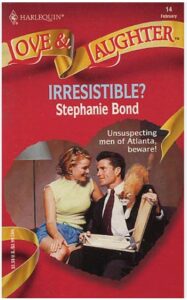
The original cover of my first book, Irresistible? published by Harlequin Enterprises February 1997.
Every author will tell you they feel like the book is real when two things happen—when you see the cover for the first time, and when you hold it in your hand. Speaking of which, in the contract the publisher specifies how many author copies will be provided. One day in January 1997, the doorbell rang, and I found a box from Harlequin on my doorstep… full of copies of my finished book! I was thrilled and couldn’t wait to send copies to my mom and take copies to members of my critique group. I set up a couple of local booksignings in Atlanta, and a dear cousin in my hometown of Olive Hill invited me to have a signing in his gift shop.
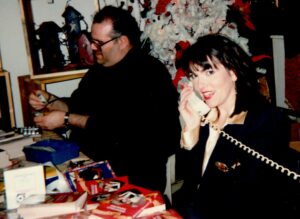
Me and my cousin Rick Stephens at his gift shop in Olive Hill, Kentucky where I had one of my first booksignings for my first book Irresistible? in February 1997. I’m not sure who I was talking to on the landline phone (remember cords, everyone?), but that was such a special day. The turnout of former classmates and teachers and customers of my store and family and friends was amazing!
Gosh, this has been such a wonderful trip down memory lane. Thank you for indulging me. I’m sure I don’t remember all the anxiety-producing moments of writing and revising that first book because I’m sure there were many! I do recall wondering if I could pull it off or if at some point, Brenda would decide she’d been had and cancel the contract. But as you can see, it all kind of worked out, and I was having the time of my life!
Now it’s (gulp!) 27 years later and coincidentally, Harlequin recently reverted the rights to my first book Irresistible? I’ve gone through it to update it and yikes, there was a lot to do.
First, technology has changed so much! And the pop culture references were so dated—I'll spare you and me the embarrassment of mentioning all of them, but here’s a short list of some of the many things I had to change. Do you remember when these things were normal?
And I know (hope) I’m a much better writer than I was when I first wrote Irresistible? I trimmed a lot, cut so many adverbs and over-writing, and generally smoothed out plot points so scenes blended more seamlessly. Ack, let me just say—I touched nearly every sentence in the book!
And while I was updating the story, I wanted to put a new cover on the book that’s more modern and more in line with my recent self-publishing branding in regard to where my name appears on the cover, etc. Because of my technical background, it probably won’t surprise you that I’m embracing Artificial Intelligence tools where they can make my life a little easier. So I asked text-to-image generator DALL-E to create a perfume bottle with bright colors and a watercolor background. It generated several images, but one in particular I really liked:
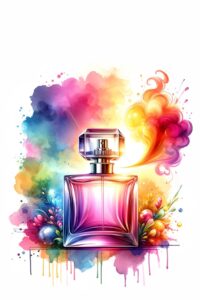
Image generated by text-to-image AI DALL-E in response to my prompt to create a perfume bottle with a colorful watercolor background.
So it’s the image I used to create a new cover for Irresistible? What do you think?
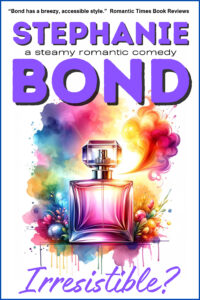
A new cover!
Plus I decided to experiment a little and I’m imbedding simple images into the text of the story to hopefully enhance the reading experience. (I’m counting on feedback from readers to let me know if you’d like to see more of that going forward as I continue to update early titles for re-release.)
And I’m happy to announce the newly updated version of Irresistible? is now available! Note that for the first 90 days (through mid-June), Irresistible? will be exclusive to Amazon and will be enrolled in Kindle Unlimited. After that, I’ll remove Irresistible? from KU but leave it on Amazon and add it to all the major online book retailers: Barnes & Noble, Apple Books, Kobo, and Google Play. Also, I’m putting Irresistible? into print.
Pfew! Back to work for me. I hope you’re enjoying THE STORIES BEHIND THE STORIES. And thank you so much for your ongoing support! ~
→Go to Chapter 4: Becoming a Full-Time Writer